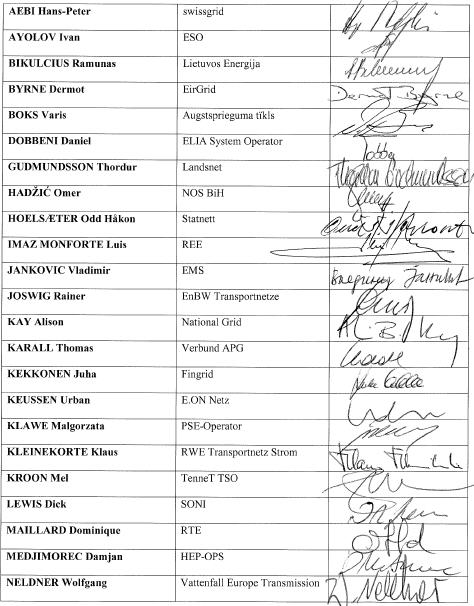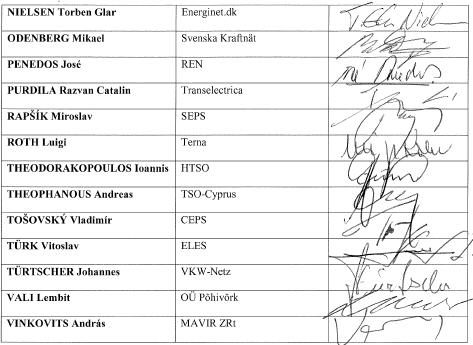|
TERMS OF REFERENCE OF THE EUROPEAN NETWORK OF TRANSMISSION SYSTEM OPERATORS FOR
ELECTRICITY (ENTSO-E)
1. Purpose
The European Union is in process of launching a 3rd legislative package on
Internal Electricity Market. . According to the package, the Transmission
System Operators (TSOs) shall found the European Network of Transmission System
Operators for Electricity (ENTSO-E) to strengthen TSO co-operation and, among
others, to draft codes to be made binding
On this basis the TSOs (The Parties) in Europe have decided to study the
possibility of establishing, by own initiative, a new association ENTSO-E to
enhance TSO cooperation prior to the entry-intoforce of the 3rd package and to
facilitate the start of the formal new body.
The Declaration of Intent signed by the TSOs expresses the intent of the Parties
to establish ENTSO-E and to continue current TSO co-operation within ENTSO-E by
winding up the current associations (ATSOI, BALTSO, ETSO, NORDEL, UCTE, and
UKTSOI). These Terms of Reference (ToR) describe the proposed main structure
and governance principles of ENTSO-E. The formal decisions of the establishment
will be made later this year based on Articles of Association and Internal
Regulations to be worked out in line with the principles described in these
Terms of Reference.
The early establishment of ENTSO-E based on the TSO preferences for how they
co-operate, and develop rules is meant to contribute positively to the EU
legislative process. Further development of this process may require that the
ENTSO-E Articles and Regulations may need adjustments for complete consistence
with the legislation after it enters into force.
The present ToR serve as a guideline for the further development of rules and
procedures of governance for ENTSO-E. Some aspects need further clarification
and adaptation before implementation in the Articles of Association and
Internal Regulations.
2.Objective of ENTSO-E
ENTSO-E will be a new association of TSOs at European level to facilitate the
following 3 broad objectives:
-
To fulfil the obligations and comply with the formal status as proposed in the
3rd package proposals.
-
To foster and to demonstrate enhanced levels of coordination and cooperation
between TSOs at a pan European and regional level ensuring optimal management,
sound technical evolution and secure operation of the European electricity
transmission system, and enhancing efficient functioning of the European
electricity market.
-
To promote the legitimate interests of TSOs.
(See attached draft statement for the objective)
3. Legal form and members of ENTSO-E
ENTSO-E will be established as an international non-profit association under
Belgian law.
The TSOs which are members of the current TSO associations can join ENTSO-E as
full members. The voting powers of these members may differ according to the
subject to be decided upon. This would mean that only those members should vote
who are affected by the measure in-question, being for example, of binding
character or financially relevant for those TSOs.
The pre-defined criteria are needed for assessing new applicants for membership.
A category of associate member shall be considered, for example, as a
transitory status for an applicant who comes from an accession country to EU.
4. Governance
It is currently planned that ENTSO-E will have a General Assembly, a Board and a
working structure consisting of Committees with project groups, the Group of
legal/regulatory experts, regional groupings and a Secretariat.
General Assembly
The GA is in charge of all the significant decisions of the association. The GA
meets some four times a year, one meeting being a higher-profile Annual
Meeting.
The GA will decide on such issues as the work programme, technical and market
codes, grid development statements, and any decision having significant
financial or other important impact on TSOs. The Annual meeting decides on such
issues as membership, Articles of Association, Internal Regulations, budget,
accounts, and the election of the president, vice presidents, the chairperson
of other ENTSO-E bodies and the Secretary General.
The General Assembly (GA) adopts its decisions through proposals usually made by
the Board and the Committees. Each full member has a seat and voting rights in
the GA as described above while associate members can attend the meetings but
are not allowed to vote. The GA is chaired by the President or in his/her
absence by a Vice-President.
For practical and efficiency reasons the GA is expected to delegate decision
powers to the Board and the Committees.
The Articles of Association will provide clear rules regarding the
decision-making. Decision-making in the GA aims at unanimity. If it is not
achievable, the GA can decide by voting based on simple or qualified majority
rules depending on the topic. Voting rights are weighted according to the
criteria to be defined later, for example the EU Council key. The voting rights
will also serve as a key for sharing of the costs of the association.
The Articles of Association of ENTSO-E may also foresee an appeal mechanism
whereby the GA is empowered to scrutinize appeals of the members against
decisions taken at lower levels.
Board
The Board of ENTSO-E coordinates the work between the Committees and prepares
proposals to be submitted for decision-making in the GA. The Board will be
responsible for overall management of the association, co-ordination of the
representation of the association and for any issues delegated to its
responsibility by the GA.
The Board will be composed at least of the chairperson of the Board and the
chairpersons of the Committees and of the Group of legal/regulatory experts.
The objective is to keep the number of members limited as to preserve the
efficiency of its functioning.
The members of the Board and its Chairperson are appointed by the GA for a fixed
term taking into account a fair representation of the regions. The President
and the Vice President(s) of the GA can attend the Board meetings.
The Secretariat prepares the meetings. The Board works on the basis of
unanimity. If unanimity is not reached, the matter will be moved to the GA for
decision.
Committees
Initially, ENTSO-E is expected to have at least Market, Operations and System
Development Committees. The Committee is in charge of professional TSO
cooperation in its area of responsibility. It prepares positions and proposals
on decisions to be taken by the higher bodies, or, upon their delegation, for
its own decision-making. The Committee can take initiatives for pan-European
harmonisation of the codes and rules, lead studies within its area and
coordinate regional activities when in the pan-European interest. The Committee
can make operative decisions to carry out its agreed work programme. The scope
of the Committees will be defined by the Work Streams C-E.
The Committees endeavour to work on the basis of unanimity. To avoid
unreasonable minority blocking or to ensure timely actions, the Committees can
make decisions based on qualified majority. Each member will have one vote.
The Committees can establish project groups under their strict control.
The Committee members (around 15 persons in each Committee) will be appointed
for a fixed term by the Board on the proposal of the respective Committee
Chairperson, taking into account a fair representation between regions. The
Chairpersons of the Committees are appointed by the General Assembly
In addition to the Committees, a Group of legal/regulatory experts will advise
the Board, the Secretariat and the Committees in the positioning of ENTSO-E
vis-a-vis ACER and EU institutions in the evolution of the regulatory
framework. It shall also ensure the regulatory compliance of the association’s
activities. The members of the Group will be appointed for a fixed term by the
Board and the Chairperson will be appointed by the GA.
As in current associations, ad hoc or permanent service teams of TSO experts can
be set up to support different bodies and Secretariat in specific matters like
websites, statistics etc.
Regional structure and interaction with the pan-European level
Regional TSO cooperation will be an important part of ENTSO-E governance.
Regional groupings are in most cases emerging from the current activities of
the existing associations in the areas of operations, system development and
market frameworks.
ENTSO-E needs to offer a flexible platform for regional activities. Regions can
be geographically different depending on the subject. For example, cooperation
on system operation relates mainly to synchronous areas while for market or
planning issues, other border lines can be relevant. Regions can also change
over time.
The regional groupings can organise themselves and make decisions on their own
issues as long as they remain consistent with the rules and guidelines approved
by ENTSO-E. Each regional grouping shall be linked to the relevant Committees
and keep it informed about its activities. The groupings shall submit their
terms of reference to the respective Committee for registration and
acknowledgement. Regional groupings may submit rules for approval by the GA if
they so choose.
The TSOs are also involved in other regional groupings that are not under the
direct governance of ENTSO-E, mainly linked to market issues. Member TSOs
participating in these regional groupings shall keep the respective Committee
informed about these initiatives, their progress and results.
5. Processes
ENTSO-E faces high requirement of efficiency and transparency. Therefore clearly
defined working processes are needed for such areas like rule making, internal
and external consultation and compliance monitoring. Whilst the rule-making
will be steered by the Committees in their respective work areas, preparation
shall follow ENTSO-E’s uniform working processes. The Group of legal/regulatory
experts will support the rule setting process. The professional process
management will be provided by the Secretariat.
6. Secretariat
The main tasks of the Secretariat are providing support to the ENTSO-E bodies,
processes and possibly to regional groupings, and communication with external
stakeholders. The Secretariat shall be neutral vis-a-vis members and be able to
work fast, efficiently and in a professional manner. The Secretariat will
provide a significant proactive focus for the activities of the association and
drafting proposals for decision.
The Secretary General will be responsible for managing the association and
staff. In the initial phase at least 10-12 persons may be needed to launch the
new association with an expectation that staff will need to grow later to about
20 persons. Some of the tasks to be defined later should be outsourced.
Additional secretarial resources may be needed to support some of the regional
activities. The management structure of the Secretariat will be designed in the
next phase of establishment process.
7. Costs and financing
A rough first estimate of the required budget is 5 million euros for the
Secretariat, outsourced services and consultancy projects. The costs will be
shared among Members in proportion to their voting rights.
The costs borne by the establishment process of ENTSO-E are financed through the budget of
ETSO. These costs can relate e.g. to the project manager, legal advisor and initial costs for staff
hired before the new association is registered.
8. Transition from the current associations
The activities of the current TSO associations will continue until ENTSO-E is established. The goal is
to establish ENTSO-E by the end of 2008. Thereafter a transition period is needed to allow a smooth
transfer of activities, commitments, resources and systems to the new association. The winding-up of
today’s current associations will occur when the transition is completed.
9. Legal status of the ToR
These Terms of Reference are not legally binding. Nothing in the ToR shall create an obligation to
enter into any agreement. Nevertheless, the Parties undertake to negotiate in good faith with the
intention of implementing the ToR. Notwithstanding Section 7 above, each Party shall bear its own
cost including for example the travelling costs of its staff and the cost of its own advisors for the work
under the ToR.
|

